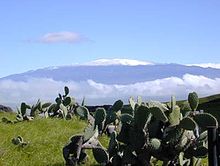Shield volcano


A shield volcano is a large volcano with shallowly-sloping sides. The name derives from a translation of "Skjaldbreiður", an Icelandic shield volcano whose name means broad shield, from its resemblance to a warrior's shield. Shield volcanoes are formed by lava flows of low viscosity — lava that flows easily. Consequently, a volcanic mountain having a broad profile is built up over time by flow after flow of relatively fluid basaltic lava issuing from vents or fissures on the surface of the volcano. Many of the largest volcanoes on Earth are shield volcanoes. The largest is Mauna Loa on the Big Island of Hawaii; all the volcanoes in the Hawaiian Islands are shield volcanoes. There are also shield volcanoes, for example, in Washington, Oregon, and the Galapagos Islands. The Piton de la Fournaise, on Reunion Island, is one of the more active shield volcanoes on earth, with one eruption per year on average.
The viscosity of magma as it approaches the surface is dependent on its temperature and composition. Shield volcanoes in the Hawaiian Islands erupt magma as hot as 700 °C (1,260 °F), compared with 850 °C (1,560 °F) for most continental volcanoes, which are usually composed of acidic lava. Because of the fluidity of the lava, major explosive eruptions do not occur. The most severe explosions occur if water enters a vent, although expanding gases in the magma can produce spectacular fountaining of the low viscosity lava.

Pyroclastic shield volcanoes, which are uncommon, are formed mostly of pyroclastics and by highly explosive eruptions. They are also known as ignimbrite shields.

Shield volcanoes are known to form on other planets. The largest known mountain in the solar system, Olympus Mons on Mars, is a shield volcano thought to be extinct. Shield volcanoes on Mars are higher and much more massive than those on Earth.
On Earth, because of plate tectonics, hotspot volcanoes eventually move away from the source of their magma and the volcanoes are individually less massive than might otherwise be the case. Shield volcanoes usually occur along constructive boundaries or above hotspots. However, the numerous large shield volcanoes of the Cascades of northern California and Oregon are over a more complex environment.
